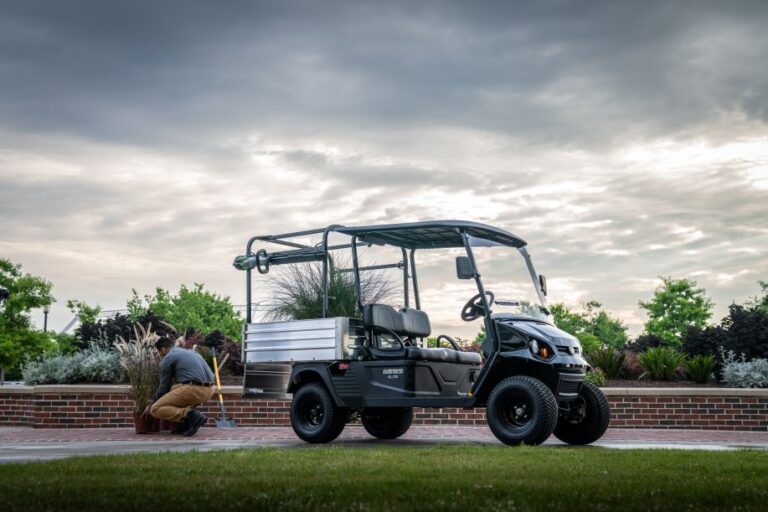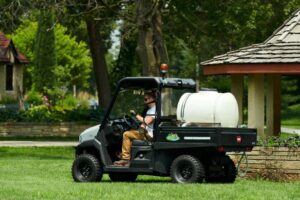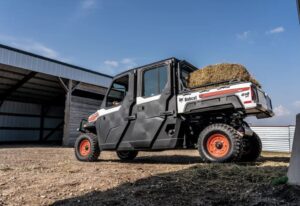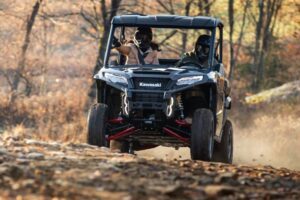By Glenn Hansen
No class of vehicles offers the productive versatility of UTVs. In a world of specialization, UTVs are here to prove the value of generalists. Yes, you can find specialists in the UTV category, but even those have the capability and attitude to mix it up.
Three broad categories
First, the utility class includes the workhorse vehicles; and they’re diverse. From speed-controlled vehicles for specialized turf to diesel-powered torque monsters to cab-equipped and climate-controlled pavement patrollers.
Second, sport-utility UTVs include a growing class of vehicles. What was once an overused catchall term for vehicles whose individual sport or utility character was questionable, this group now includes specialized comfort features and performance traits that rival on-road SUVs.
Third, pure sport UTVs are the machines that get most of the attention (sometimes good, sometimes not). The Polaris RZR has dominated this class for years, but the Can-Am Maverick and Honda Talon offer competition for racers and trail enthusiasts. Let’s break it down further.
Utility: Turf and hard surface driving
Deere’s Gator line and Toro’s Workman UTX line are among the most popular models in this category, and serve users with turf care in mind – from baseball fields to golf courses. Both of these vehicle lines, as well as the Landmaster Commercial vehicles, are available in gas or electric. That gives users convenience for their needs and for fleet fuel options. We expect to see an increase in the number of battery-powered offerings – whether lithium-ion or other – in the near future.
One of the most important characteristics of these work machines is their ability to tread lightly on sensitive soil. While low-psi, turf-specific tires help reduce the impact of any UTV, machines with a rear differential – transaxle or other non-locking – mean lower impact when the tires are turning. Several of the larger 4×4-equipped sport-utility UTVs feature a “turf mode” setting that essentially makes them 1-wheel-drive machines to accomplish the same light steering impact.
Even more important for any of these pure-work machines is the owner’s ability to customize. One look at the Toro Workman options list shows canopy, solid folding windshield, 4-seat configuration, 6-foot flat bed, storage box, trash can mount, bed racking, electric bed lift, Roll-Over Protection System (ROPS)-certified hard cab, 2-post ROPS kit, beverage cart, range cage, glass windshield, medical bed and more.
Although John Deere Gators, for example, are often sold alongside Deere compact tractors and mowers, others, like Toro Workman UTVs could be sold through distributors or purchased in fleet arrangements or acquired by lease. Pro users should look closely at used vehicles too. It’s easy to check engine hours and maintenance history, and visibly inspect the condition of wear items.
Utility: Farm and ranch work
For landowners like farmers and ranchers UTVs are more accessible and easier to use than a pickup truck. We used to add “more affordable” to that advantage list, but that’s not always the case today. It’s not difficult to spend $25,000 or more on a 4×4 UTV, and that’s not far from the price of a new mid-size pickup truck. You can find used vehicles in this group, but they tend to get driven hard, and you’re less likely to find a well-maintained bargain.
Still, UTVs are more useful for many around-the-acreage tasks and will go places many pickups might not. The best example of that, and one of our favorites in this category, is the Can-Am Defender 6×6 UTV. With selectable 4-wheel or 6-wheel drive, this vehicle will go nearly anywhere while carrying people, tools and equipment.
Bobcat’s UV34 line of UTVs includes four variations; users can choose a gas or diesel engine, and single-row or two-row seating. Unlike the UTVs from some of the powersports-focused companies (Can-Am, Polaris, etc.), the Bobcat UV models are speed limited to 35 mph. “Performance” means work to Bobcat, and owners can choose to limit speeds further depending on the use environment. These vehicles come standard with a ROPS-approved cab.
The “Kleenex” of this category is the Kawasaki Mule. Kawasaki now offers more than 40 models with different drive systems, engine sizes, fuel types, seating configurations and prices that start under $10K.
Utility: Low speed and street ready
The Utility categories start to blend here. You can find low-speed workers in the above groupings, but some vehicles are designed strictly for low-speed use, even street-legal ones depending on local laws. If you run landscape teams on large commercial lots or in HOA-type neighborhoods, a street-legal, low-speed vehicle that can carry tools and people could be a good option.
The Cushman Hauler Pro LSV (pictured top) is one of several Hauler models in the Cushman Utility category. Users can choose gas or electric, and a variety of configurations for niche uses. The “LSV” designation means the vehicle must meet federally regulated safety standards to be deemed street legal.
Sport-utility: Work advantage
The sport-utility category is large and growing. We try to separate it into more work-focused and more fun-focused, but there is a lot of cross over, and you’d need to compare specific details such as suspension travel, load-carrying capacities, available accessories and more. Look for comfort features in this category, as well as features such as power steering and selectable four-wheel drive. Plus, the ability to accessorize and customize will define your capabilities with these machines.
Honda calls its Pioneer 500 side-by-side a “rec-utility” vehicle. Priced around $9,000 and sized to fit in a full-size pickup bed, this small UTV is a versatile light-duty worker. Honda UTVs and ATVs feature the company’s dual-clutch transmission. This auto tranny uses no belts, and allows for a manual, paddle-shifted mode for more power control.
The CFMoto U Force is a UTV line from a company growing a brand reputation across the powersports world. The U Force lineup includes a few models, and each has a standard tilting dump bed, LED lighting and a front-mounted winch. Those work-focused features can come in handy for recreation too.
Also consider Cub Cadet’s Challenger UTV line, which offers a wide range of accessories inclined toward utility.
Sport-utility: Play advantage
The sport side of sport-utility includes vehicles marketed to just about anyone who wants to spend time outside. This is the do-it-all category, and includes models with spend-it-all price points.
The Polaris Ranger XD1500 Northstar Edition, with its climate-controlled cab, JBL audio system and 110-hp. engine has a suggested retail price of $40,000. The 6-seat model retails for $50K. That’s Ford F150 territory.
The new Kawasaki Ridge is intended for this work-hard/play-hard buyer too. It features an HVAC system and Garmin navigation, among other comfort features. Like the Polaris, the Ridge is meant for drivers who will spend a lot of time in and around the vehicle, whether for sporting outdoors situations or a day of work.
The Yamaha line of Wolverine UTVs fits well for those wanting more play than work, and more affordability than the ultra-premium Polaris XD models. The Wolverine line features two-seater models with a cargo bed, or four-seaters with seats that fold to expose a small cargo bed. These are trail-focused people movers.
Pure sport
UTV racing is increasingly popular, from woods courses in the east and Midwest to desert racing throughout the southwest. Factory-supported teams even compete in events like the Dakar Rally in Africa and the Middle East. The Polaris RZR has been a class sales leader, though the Can-Am Maverick and Honda Talon are making advances.
Glenn Hansen is editor of OPE+ magazine, sister publication to SportsField Management magazine.




